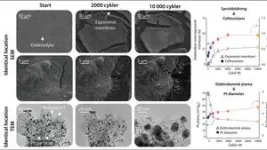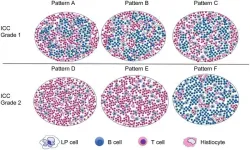(Press-News.org) More efficient and longer-lasting fuel cells are essential for fuel cell-powered heavy-duty hydrogen vehicles to be an alternative to combustion fuelled counterparts. Researchers at Chalmers University of Technology, Sweden, have developed an innovative method to study and understand how parts of fuel cells degrade over time. This is an important step towards the improved performance of fuel cells and them becoming commercially successful.
Hydrogen is a fuel alternative that is becoming increasingly interesting for heavy-duty vehicles. Hydrogen-powered vehicles only emit water vapour as exhaust, and if the hydrogen is produced using renewable energy, it is completely free of carbon dioxide emissions. Unlike battery-powered electric vehicles, hydrogen-powered vehicles do not need to burden the electricity grid, as hydrogen can be produced and stored when electricity is cheap. For some hydrogen-powered vehicles the propulsion comes from a so-called fuel cell. However, hydrogen-fuel-cell-powered vehicles are limited by a relatively short lifespan, because fuel cell components, such as electrodes and membranes, degrade over time. It is this problem that the recent study addresses.
Researchers at Chalmers University of Technology have developed a new method for studying what affects the ageing of fuel cells by tracking a specific particle in the fuel cell during use. The team of researchers have studied an entire fuel cell by taking it apart at regular intervals. Using advanced electron microscopes, they have then been able to follow how the cathode electrode degrades in specific areas during the cycles of use. Previous studies have been done on so-called half-cells, which are similar (but not the same as) half of a fuel-cell and are carried out under conditions that differ significantly from the real fuel cell.
Better understanding with new experimental method
"It has previously been assumed that the performance would be affected by the fuel cell being disassembled and studied in the way we have done, but it turned out that this assumption is not correct, which is surprising," says research leader Björn Wickman, Associate Professor at the Department of Physics at Chalmers.
The researchers at Chalmers have been able to explore how the material in the fuel cell degrades at both the nano and micro level, and pinpoint exactly when and where the degradation occurs. This provides valuable information for the development of new and improved fuel cells with a longer lifespan.
"From previously only looking at how the fuel cell has aged after use, we have now been able to look into the middle stage," says doctoral student Linnéa Strandberg at Chalmers. “Being able to follow a single, chosen particle within a specific area, provided a much better understanding of the degradation processes. Greater knowledge of these is an important step on the way to designing new materials for fuel cells or to adjust the control of the fuel cell.”
New method paves way for longer lasting fuel cells
The U.S. Department of Energy (DOE) has pointed out that improved lifetime of fuel cells is one of the most important goals to reach before fuel cell-powered hydrogen vehicles can become commercially successful. According to the industry, a truck needs to be able to withstand 20,000 – 30,000 hours of driving over its lifetime, which a fuel cell-powered hydrogen truck cannot achieve today.
"We have now laid a foundation on which to build for the development of better fuel cells. Now we know more about the processes that take place in the fuel cell and at what point over the lifetime of the fuel cell they occur. In the future, the method will be used to develop and study new materials that can give the fuel cell a longer lifespan," says Björn Wickman.
Facts: How a fuel cell works
The core of a fuel cell consists of three active layers, two electrodes – anode and cathode respectively – with an ion-conducting membrane in the middle. Each individual cell provides a voltage of about 1 volt. The electrodes contain catalyst material, and hydrogen and oxygen are added to them. The resulting electrochemical process generates clean water and electricity that can be used to power a vehicle.
More about the research:
The research group at Chalmers that has developed the method consists of doctoral student Linnéa Strandberg and Associate Professor Björn Wickman, both at the Department of Physics, Victor Shokhen, former postdoc at the Department of Physics, and Magnus Skoglundh, professor at the Department of Chemistry and Chemical Engineering.
The research has been presented in three different scientific articles:
Carbon Support Corrosion in PEMFCs Followed by Identical Location Electron Microscopy, ACS Catalysis, 16 May 2024.
Fuel cell electrode degradation followed by identical location transmission electron microscopy (Journal of Material Chemistry A, 4 September 2023)
Impact of Accelerated Stress Tests on the Cathodic Catalytic Layer in a Proton Exchange Membrane (PEM) Fuel Cell Studied by Identical Location Scanning Electron Microscopy (ACS Applied Energy Materials, 18 August 2022)
This project was financially supported by the Swedish Foundation for Strategic Research and the Swedish Research Council and performed within the Competence Centre for Catalysis, which is hosted by Chalmers University of Technology and financially supported by the Swedish Energy Agency and the member companies Johnson Matthey, Perstorp, Powercell, Preem, Scania CV, Umicore and Volvo Group.
Scanning electron microscopy and transmission electron microscopy were performed at Chalmers Materials Analysis Laboratory (CMAL).
For more information, please contact:
Linnéa Strandberg, Doctoral Student, Department of Physics, Chalmers University of Technology, Sweden, linnea.strandberg@chalmers.se
Björn Wickman, Associate Professor, Department of Physics, Chalmers University of Technology, Sweden, bjorn.wickman@chalmers.se +46 31 772 51 79
END
A method that paves the way for improved fuel cell vehicles
2024-08-14
ELSE PRESS RELEASES FROM THIS DATE:
How air-powered computers can prevent blood clots
2024-08-14
A new, air-powered computer sets off alarms when certain medical devices fail. The invention is a more reliable and lower-cost way to help prevent blood clots and strokes — all without electronic sensors.
Described in a paper in the journal Device, the computer not only runs on air, but also uses air to issue warnings. It immediately blows a whistle when it detects a problem with the lifesaving compression machine it is designed to monitor.
Intermittent pneumatic compression or IPC devices are leg sleeves that fill with air periodically and ...
Fear of appearing prejudiced can inhibit accurate performance feedback to women
2024-08-14
PULLMAN, Wash. – Evaluators who want to avoid appearing prejudiced may overcorrect and give women inflated performance feedback, new research indicates, which is a practice that could ultimately hinder their ability to improve and advance.
A Washington State University-led research team investigated the connection between overly positive performance reviews and “protective paternalism,” the belief that women need to be handled carefully and shielded from harm.
While it may be well-intentioned, ...
Chromatin structure plays a key role in canine social behavior evolution
2024-08-14
A new study on dogs found that chromatin's spatial structure has a significant role in the evolution of social behavior. Chromatin, the compact form of DNA, not only packages genetic material but also plays a crucial role in gene regulation. This study demonstrates that both the linear sequence of DNA and its three-dimensional configuration are linked to friendly behavior shaped by dog domestication, providing new insights into the molecular mechanisms underlying social traits.
Behavioral traits such as sociability are influenced by numerous genes, their interactions, environmental factors, and individual life experiences.
Because ...
Work-related stress may increase the risk of an irregular heart rhythm
2024-08-14
Research Highlights:
Adults in white-collar jobs in Canada with high job strain and for whom significant efforts are met with low rewards (such as low salary or recognition) may face a 97% increased risk for developing the irregular heart rhythm condition known as atrial fibrillation, or AFib or AF, compared to workers not exposed to these work stressors.
Separately, high job strain alone was associated with an 83% higher risk of developing AFib, and effort-reward imbalance alone was associated with a 44% greater risk.
Recognizing and addressing these stressors at work may be an effective strategy ...
Massive biomolecular shifts occur in our 40s and 60s, Stanford Medicine researchers find
2024-08-14
If it’s ever felt like everything in your body is breaking down at once, that might not be your imagination. A new Stanford Medicine study shows that many of our molecules and microorganisms dramatically rise or fall in number during our 40s and 60s.
Researchers assessed many thousands of different molecules in people from age 25 to 75, as well as their microbiomes — the bacteria, viruses and fungi that live inside us and on our skin — and found that the abundance of most molecules ...
Study reveals that memories of the COVID-19 pandemic lockdowns predict declines in psychological well-being of children and adolescents
2024-08-14
The COVID-19 pandemic and the lockdown measures to prevent contagion resulted in extensive disruptions in children’s and adolescents’ everyday lives. A new study in Child Development from the Aarhus University Hospital in Denmark, University of California, Riverside and University of California, Davis in the United States, investigated personal memories (i.e., memories for episodes experienced in one’s own life) about the first lockdown in Denmark in Spring 2020 among children and adolescents and how this may have impacted their psychological well-being over the following year.
For context, in ...
Severe menopause symptoms may take toll on brain health
2024-08-14
CLEVELAND, Ohio (August 14, 2024)—With more than 24 million people globally living with dementia without a cure in sight, there is a lot of focus on ways to prevent and delay cognitive impairment. A new study suggests that severe menopause symptoms such as hot flashes and depression can negatively affect cognitive function in postmenopausal women. Results of the study are published online today in Menopause, the journal of The Menopause Society.
In conjunction with our aging population, dementia diagnoses are on the rise. It ...
Historic map reveals how mussel farm is bringing shellfish reefs back to the seabed
2024-08-14
The UK’s first large scale offshore mussel farm is allowing shellfish reefs to return to parts of the seabed off England’s south coast for the first time in up to 150 years, a new study has revealed.
Researchers have spent the past decade examining the environmental impact of the farm, which was first established in Lyme Bay off the coast of South Devon in 2013.
In that time, the seabed beneath the farm’s ropes has begun to undergo a transformation as mussels from the lines are ...
Power up your health with self-sustaining electronics
2024-08-14
Imagine a coat that captures solar energy to keep you cozy on a chilly winter walk, or a shirt that can monitor your heart rate and temperature. Picture clothing athletes can wear to track their performance without the need for bulky battery packs.
University of Waterloo researchers have developed a smart fabric with these remarkable capabilities. The fabric has the potential for energy harvesting, health monitoring, and movement tracking applications.
The new fabric developed ...
Histopathologic features and differential diagnosis in challenging cases of nodular lymphocyte predominant B-cell lymphoma/Nodular Lymphocyte Predominant Hodgkin Lymphoma
2024-08-14
This review offers an in-depth exploration of Nodular Lymphocyte Predominant Hodgkin Lymphoma (NLPHL), highlighting its distinct characteristics across various domains such as epidemiology, clinical presentation, histopathology, immunophenotype, genetic findings, and challenges in differential diagnosis.
Epidemiology and Clinical Presentation
NLPHL is a relatively rare subtype of Hodgkin lymphoma, comprising approximately 10% of all Hodgkin lymphoma cases. It predominantly affects males, with a higher incidence observed ...







